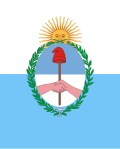Mendoza Province
| Mendoza | |||
| Province | |||
|
|||
| Capital | Mendoza | ||
|---|---|---|---|
| Area | 148,827 km² (57,462 sq mi) | ||
| Population | 1,692,000 (2005 est.) [1] | ||
| Density | 11.4 /km² (30 /sq mi) | ||
| Governor | Celso Jaque | ||
| - Senators | María Perceval, Ernesto Sanz, Monica Troadello | ||
| ISO 3166-2 code | AR-M | ||
| Demonym | mendocino | ||
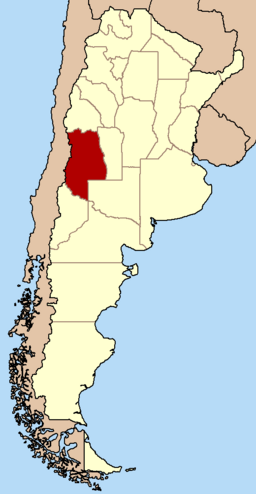 |
|||
| Website: http://www.mendoza.gov.ar | |||
Mendoza is one of the 23 provinces of Argentina, located in the western central part of the country in the Cuyo region. Neighboring provinces are from the north clockwise San Juan, San Luis, La Pampa,and Neuquén. To the west is Chile.

Contents |
History

Evidence of inhabitants in the area date to 2,000 years BC. On the basin of the Atuel River, 300 years BC lived a group of people that lived of hunting, and cultivation of maize, pumpkins and beans.
Some of the tribes present at the arrival of the Spaniards include the Huarpes and Puelches. The first Spanish conquerors came around 1550 from the Viceroyalty of Peru. In 1561 the city of Mendoza was founded by the military man Pedro del Castillo.
With the creation of the Viceroyalty of the Río de la Plata, its 30,000 inhabitants became part of the intendency of Cuyo de Córdoba del Tucumán, but in 1813 the intendency of Cuyo separated from the other provinces.
José de San Martín was governor of the region and received important support from Mendoza when he took off with his Army of the Andes from Plumerillo in 1817 to cross the Andes in a campaign to release Chile from the "oppression of Spain".

The 1861 earthquake nearly destroyed the city of Mendoza, which had to be almost entirely reconstructed. In 1885 the railways reach the Province, allowing a fluent transport for the wines of the regions towards the ports of Buenos Aires. Until 1812 the province was part of Cordoba Province; from 1812-1820 it was known as Cuyo Province.
Following the development of wine industry in the province around 1900, Mendoza began to grow quickly, attracting tens of thousands of European immigrants, particularly Spaniards. In 1939 the National University of Cuyo, one of the most important of the country, was founded.

Partly in reaction to Pres. Juan Peron's populist policies, some of which taxed agriculture heavily to finance urban development and public works, Mendoza landowners formed the conservative Democratic Party, which secured the Vice-governor's post in 1958. Increasing their presence in the Mendoza Legislature, the Democrats became an obstacle to progressive Governor Ernesto Ueltschi, an ally of president Arturo Frondizi's. Enjoying majorities in both houses by 1961, they had Gov. Ueltschi removed and Democrat Vice-governor Francisco Gabrielli appointed in his stead. Elected governor in his own right in 1963, Gov. Gabrielli was deposed following the June, 1966, coup against Pres. Arturo Illia; but still benefiting from conservative credentials, he was appointed de facto governor by the same military regime in 1970.
In contrast to the pragmatism that had distinguished his 1963-66 term, Gabrielli governed with a hard line, feezing state salaries and ordering large utility rate increases, as well as using the Mendoza police to repress dissent and taking foreign policy prerogatives like collaborating with Chilean saboteurs opposed to their country's new Marxist president, Salvador Allende. These events came to a head in April, 1972, however, when violent protests forced the newly unpopular Gabrielli to resign.[2]
Upon the return to democracy in March, 1973, Mendoza voters turned to a left-leaning Peronist, Alberto Martinez Baca. Quickly enacting needed labor and land reforms, Martinez Baca, however, made the mistake of appointing affiliates of the extreme-left Montoneros movement, an organization whose armed wing had perpetrated a string of violent crimes since 1970 (and would continue to do so). Alarmed by this move from the otherwise pragmatic Marinez Baca, President Peron had him removed in June, 1974.
Becoming very independent-minded as voters following these two disappointments, Mendoza voters have elected centrist Radical Civic Union as well as populist Justicialist (Peronist) Party lawmakers since the Argentina's sustained return to democracy in 1983. Though Mendoza has generally prospered since then, its critical wine industry was left reeling from the 1983 near-collapse of state-owned vintner GIOL, whose dictatorship era receivers had ran the wine conglomerate (then the world's largest outside Europe) into US$6 billion of debt.[3] GIOL closed in 1991.
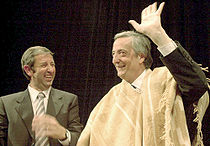
Elected in 2003, Radical Civic Union governor Julio Cobos highlighted this independent sentiment by parting ways with many in his party and endorsing newly-elected Peronist president Nestor Kirchner's policies in 2004. Over the opposition of his party, Julio Cobos stood as running mate to first lady Cristina Fernández de Kirchner of the Front for Victory in the presidential elections of October 2007. Fernández and Cobos won in the first round and Cobos is now Vice President of Argentina. He was replaced by pro-Kirchner Justicialist Celso Jaque as governor. The province is represented by three senators in the Argentine Senate, currently María Perceval, Ernesto Sanz and Mónica Troadello. Mendoza is represented by 10 deputies in the Argentine Chamber of Deputies.
On July 16, 2008, Vice-president Cobos stunned observers by casting the tie-breaking vote against a presidentially-sponsored measure in the Senate that would have raised export taxes on an array of agricultural goods.
Geography and climate

The geography of the province descends from the 6959 m of the Aconcagua mountain to the semi-flat lands of the east. A series of longitudinal valles such as the Uspallata, separate the Andes from the Precordillera lower mountains. To the east, the Cuyean plains are crossed by tributaries of the Desaguadero River. Other important rivers include Mendoza River, Tunuyán River, Diamante River and the Atuel River.
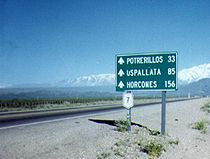
The climate is continental, sunny and dry in the entire territory of the province, with warm summers and relatively cold winters. The arid soil due to the scant precipitation and the great temperature difference between day and night allows mainly xerophytes and few trees to grow. The annual precipitation lies between 150 and 350 mm, and hail is not uncommon and an important problem in the regional viticulture. There are fertile lands surrounding the basins of the many rivers, born in glaciers of the Cordillera.
Different wind fronts affect the landscape, mainly the Zonda wind, but also the mild Pampero, the warm Viento Norte and in winter the very rare Sudestada from the Southeast. This latter one affects mostly the pampas.
Economy

Famed worldwide for its viticulture (with 70% of the 1.5 billion liters in Argentine wine production),[4] the Mendoza economy (Argentina's fifth largest) is, however, quite diversified. Its 2006 output was estimated at US$13.8 billion, or, US$8,720 per capita (about the national average).[5] Agriculture, to be sure (though 7% of the total economy)[6], has long accounted for much of Menodoza's foreign exchange earnings (followed closely by tourism, mainly from Chile). Besides wine, other important crops (mainly for the Argentine market) are apples, pears, tomatoes, onions, plums, olives, cherries, peaches and quince. Apiculture, with 30,000 beehives, is another growing activity favoured by Mendoza's dry weather.
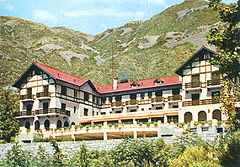
Mining is important to the Mendoza economy and has grown sharply in recent years, now accounting for 22% of output in 2005 (nearly 5 times the national average)[6]. Fourteen percent of the national reserves of petroleum are in Mendoza, also home to large-scale mining of lime and uranium. Manufacturing has long contributed to the province's prosperity and still accounts for 16% of the economy.[6] Mendoza's main industries are, of course, wine production with 1,200 wineries turning out 1.1 billion liters in 2005, followed by canned fruits, a large petroleum refinery (in Luján de Cuyo), cement and others.

Mendoza's services sector is somewhat less developed and diversified than the national average. Tourism, long active in the scenic province, has, since the 2002 devaluation of the Argentine Peso, become one of its most important sources of income, with around 700,000 visitors per year. The main attractions are the Las Leñas ski centre, the Aconcagua mountain, and the provincial parks of the Atuel Canyon, Puente del Inca, Guaymallén and others. With the recent developments in Argentine wine production, wine tourism has also become very popular, with numerous wine-tourism oriented hotels appearing throughout the province. Wineries generally offer free tours of the premises with wine-tastings at the conclusion of the tour. In the wine-producing region, the Fiesta de la Vendimia (grape harvest festival) receives many visitors in late February or early March. The Christ the Redeemer of the Andes statue in the mountains on the Chilean border is a destination for many excursions.
Political division


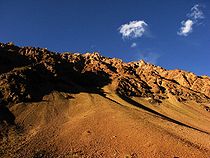

The province is divided into 18 departments (Spanish: departamentos), called municipalities. Each municipality is divided into one or more districts, corresponding to the jurisdictions of cities and towns. Each municipal government, formed by an Executive Department (led by a mayor or intendente) and a Deliberative Department (legislature), is in charge of the local services. The mayor is elected by the simple majority of the popular vote every four years, while half of the Deliberative body is renewed every two years (re-election is allowed in both cases). The municipalities can dictate a number of regulations in accord with to the provincial constitution and the Organic Law of Municipalities, but cannot create new taxes; they may only charge for services. The most populated cities within a municipality may have citizens' commissions appointed by the municipal government to perform certain functions (they are not self-ruled). [7]
- Capital Department (Mendoza) - Capital
- General Alvear Department (General Alvear)
- Godoy Cruz Department (Godoy Cruz)
- Guaymallén Department (Villa Nueva)
- Junín Department (Junín)
- La Paz Department (La Paz)
- Las Heras Department (Las Heras)
- Lavalle Department (Villa Tulumaya)
- Luján de Cuyo Department (Luján de Cuyo)
- Maipú Department (Maipú)
- Malargüe Department (Malargüe)
- Rivadavia Department (Rivadavia)
- San Carlos Department (San Carlos)
- San Martín Department (San Martín)
- San Rafael Department (San Rafael)
- Santa Rosa Department (Santa Rosa)
- Tunuyán Department (Tunuyán)
- Tupungato Department (Tupungato)
References

See also
- 1782 Mendoza earthquake
- 1861 Mendoza earthquake
- 1920 Mendoza earthquake
- 1985 Mendoza earthquake
- 2006 Mendoza earthquake
- Reserve of Ñacuñán
- Universidad Nacional de Cuyo
- UTN
External links
- Official site (Spanish)
- Mendoza Ministry of Tourism and Culture (in Spanish)
- Mendoza guide of Tourism and Culture (in Spanish)
- Discover Mendoza - Turism in Mendoza (in Spanish)
- Universidad Nacional de Cuyo (in Spanish)
- Map of Mendoza
- Pictures of Mendoza and its wine regions
- Wines of Mendoza on Vinismo
|
||||||||||
